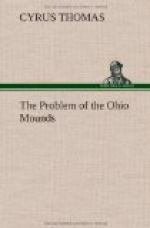to the eastward, until they should find a country
that pleased them. The spies which the Lenape
had sent forward for the purpose of reconnoitring,
had long before their arrival discovered that the
country east of the Mississippi was inhabited by a
very powerful nation who had many large towns built
on the great rivers flowing through their land.
Those people (as I was told) called themselves Talligew
or Tallgewi. Many wonderful things are told of
this famous people. They are said to have been
remarkably tall and stout, and there is a tradition
that there were giants among them, people of a much
larger size than the tallest of the Lenape. It
is related that they had built to themselves regular
fortifications or intrenchments, from whence they
would sally out, but were generally repulsed.
I have seen many of the fortifications said to have
been built by them, two of which, in particular, were
remarkable. One of them was near the mouth of
the river Huron, which empties itself into the Lake
St. Clair, on the north side of that lake, at the
distance of about 20 miles northeast of Detroit.
This spot of ground was, in the year 1776, owned and
occupied by a Mr. Tucker. The other works, properly
intrenchments, being walls or banks of earth regularly
thrown up, with a deep ditch on the outside, were on
the Huron River, east of the Sandusky, about six or
eight miles from Lake Erie. Outside of the gateway
of each of these two intrenchments, which lay within
a mile of each other, were a number of large flat
mounds in which, the Indian pilot said, were buried
hundreds of the slain Talligewi, whom I shall hereafter,
with Colonel Gibson, call Alligewi. Of these
intrenchments Mr. Abraham Steiner, who was with me
at the time when I saw them, gave a very accurate
description, which was published at Philadelphia in
1789 or 1790, in some periodical work the name of
which I can not at present remember.
When the Lenape arrived on the banks of the Mississippi
they sent a message to the Alligewi to request permission
to settle themselves in their neighborhood. This
was refused them, but they obtained leave to pass
through the country and seek a settlement farther
to the eastward. They accordingly began to cross
the Namaesi-Sipu, when the Alligewi, seeing that their
numbers were so very great, and in fact they consisted
of many thousands, made a furious attack upon those
who had crossed, threatening them all with destruction,
if they dared to persist in coming over to their side
of the river. Fired at the treachery of these
people, and the great loss of men they had sustained,
and besides, not being prepared for a conflict, the
Lenapi consulted on what was to be done; whether to
retreat in the best manner they could, or to try their
strength, and let the enemy see that they were not
cowards, but men, and too high-minded to suffer themselves
to be driven off before they had made a trial of their
strength and were convinced that the enemy was too
powerful for them. The Mengwe, who had hitherto
been satisfied with being spectators from a distance,
offered to join them, on condition that, after conquering
the country, they should be entitled to share it with
them; their proposal was accepted, and the resolution
was taken by the two nations, to conquer or die.




